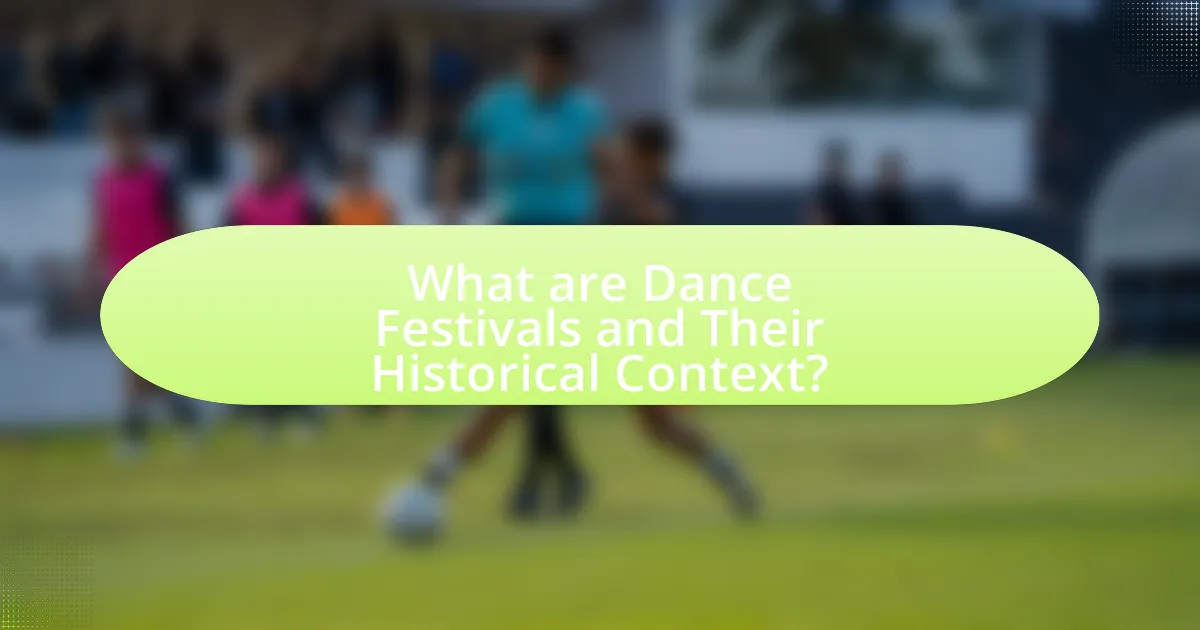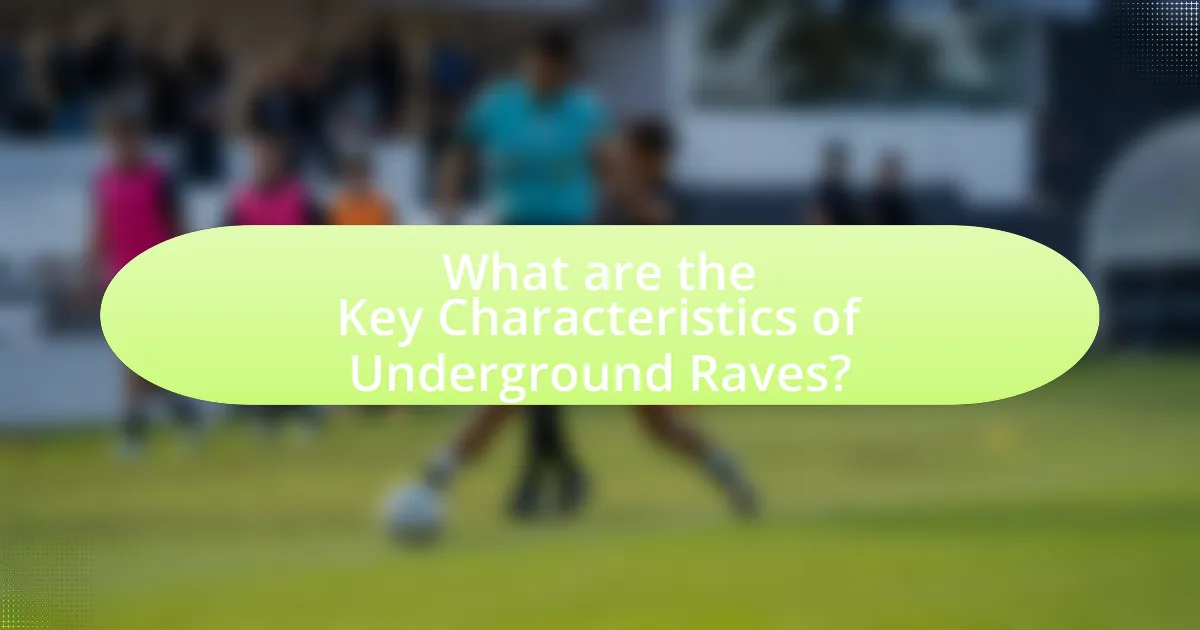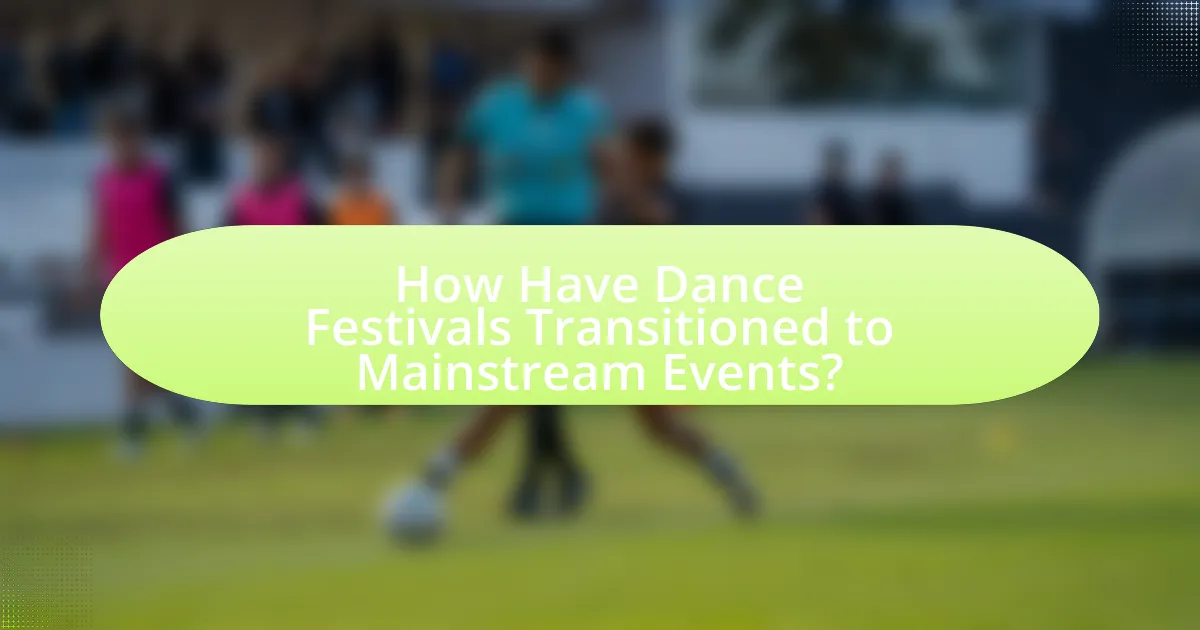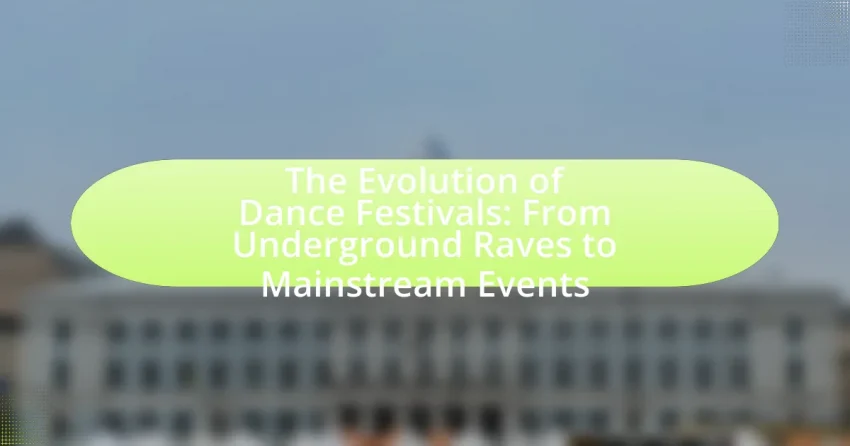Dance festivals are organized events that celebrate various forms of dance, evolving from communal rituals to large-scale gatherings that attract diverse audiences. The article explores the historical context of dance festivals, tracing their origins from ancient cultural practices to the emergence of underground raves in the late 20th century, which significantly influenced contemporary festival culture. It examines the impact of societal changes, technological advancements, and cultural movements on the evolution of these events, highlighting the transition from underground raves to mainstream festivals. Additionally, the article discusses the economic implications of dance festivals, their role in community building, and the challenges organizers face in maintaining the original spirit amidst commercialization.

What are Dance Festivals and Their Historical Context?
Dance festivals are organized events that celebrate various forms of dance, often featuring performances, workshops, and social dancing. Historically, these festivals have roots in cultural and religious traditions, evolving from communal gatherings to large-scale events that attract diverse audiences. For instance, the first documented dance festival, the Festival of Dionysus in ancient Greece, celebrated the god of wine and fertility through theatrical performances and dance, laying the groundwork for future festivals. Over time, the emergence of modern dance festivals, particularly in the late 20th century, reflected societal changes, with underground raves in the 1980s and 1990s transitioning into mainstream events that now encompass a wide range of dance styles and cultural expressions.
How did dance festivals originate?
Dance festivals originated from communal celebrations and rituals that featured dance as a central element, often linked to agricultural cycles, religious practices, or cultural traditions. Historically, these gatherings served as a means for communities to express joy, celebrate milestones, and reinforce social bonds. For instance, ancient cultures such as the Greeks and Romans held festivals that included dance as a form of worship and entertainment, while in the 20th century, the emergence of underground raves in urban settings marked a significant shift, emphasizing electronic music and countercultural expression. This evolution laid the groundwork for contemporary dance festivals, which now attract diverse audiences and feature a wide range of musical genres and artistic performances.
What cultural movements influenced the birth of dance festivals?
The birth of dance festivals was influenced by several cultural movements, notably the counterculture of the 1960s and 1970s, the rise of electronic music in the 1980s, and the rave culture of the 1990s. The counterculture movement emphasized communal experiences and artistic expression, leading to early gatherings that celebrated music and dance as forms of liberation. The emergence of electronic music, particularly house and techno, provided the soundtrack for these gatherings, while the rave culture introduced large-scale, immersive events that combined music, art, and a sense of community. These movements collectively laid the groundwork for the modern dance festival scene, which has evolved into mainstream events attracting diverse audiences worldwide.
How did early underground raves shape the festival landscape?
Early underground raves significantly shaped the festival landscape by introducing a culture of community, self-expression, and immersive experiences. These raves, which emerged in the late 1980s and early 1990s, fostered a sense of belonging among attendees, often emphasizing inclusivity and freedom of expression. The DIY ethos prevalent in underground raves led to innovative event organization and unique venue choices, such as warehouses and outdoor spaces, which later influenced mainstream festival formats.
Moreover, the underground rave scene popularized electronic dance music genres, such as techno and house, which became staples in larger festivals. The emphasis on experiential elements, such as elaborate light shows and interactive art installations, set a precedent for the production quality seen in contemporary festivals. The transition from underground to mainstream was marked by events like the Love Parade in Germany, which began as a small gathering and evolved into a massive festival, illustrating the impact of early raves on the broader festival culture.
What role do dance festivals play in contemporary culture?
Dance festivals play a significant role in contemporary culture by serving as platforms for artistic expression, community building, and cultural exchange. These events foster creativity and innovation in dance, showcasing diverse styles and talents from around the world. For instance, festivals like the Edinburgh Festival Fringe and the International Dance Festival Birmingham attract thousands of participants and audiences, highlighting the importance of dance in cultural dialogue and social cohesion. Additionally, they contribute to local economies through tourism and related activities, demonstrating their impact beyond the arts.
How do dance festivals reflect societal changes?
Dance festivals reflect societal changes by serving as cultural barometers that showcase shifts in social norms, values, and community dynamics. For instance, the transition from underground raves to mainstream events illustrates a growing acceptance of electronic dance music and the associated lifestyle, highlighting changes in youth culture and leisure activities. Additionally, festivals often address contemporary social issues, such as inclusivity and environmental sustainability, as seen in events like Coachella and Tomorrowland, which promote diversity and eco-friendly practices. This evolution indicates a broader societal embrace of diversity and a collective response to global challenges, reinforcing the role of dance festivals as platforms for social expression and change.
What impact do dance festivals have on local economies?
Dance festivals significantly boost local economies by increasing tourism, generating revenue, and creating jobs. For instance, a study by the National Endowment for the Arts found that arts festivals, including dance events, can attract thousands of visitors, leading to increased spending in local businesses such as hotels, restaurants, and shops. Additionally, dance festivals often require local staffing for security, event management, and hospitality, thereby creating temporary and permanent job opportunities. In 2019, the Electric Daisy Carnival in Las Vegas generated an estimated $350 million in economic impact, illustrating how large-scale dance festivals can substantially contribute to local economies.

What are the Key Characteristics of Underground Raves?
Underground raves are characterized by their illicit nature, unique music styles, and a strong sense of community. These events often take place in non-traditional venues such as warehouses, forests, or abandoned buildings, which adds to their secretive appeal. The music at underground raves typically features genres like techno, house, and drum and bass, emphasizing a raw and uncommercial sound. Additionally, the culture surrounding underground raves promotes inclusivity and self-expression, often encouraging attendees to dress creatively and embrace individuality. The emphasis on DIY ethics and grassroots organization further distinguishes these events from mainstream festivals, fostering a sense of authenticity and rebellion against commercialism.
How do underground raves differ from mainstream dance festivals?
Underground raves differ from mainstream dance festivals primarily in their organization and cultural ethos. Underground raves are often unlicensed, held in clandestine locations, and emphasize a DIY spirit, fostering a sense of community and rebellion against commercialism. In contrast, mainstream dance festivals are typically large-scale, commercially organized events with permits, sponsorships, and a focus on mainstream music genres, attracting a broader audience. For example, events like Burning Man, while having underground roots, have evolved into large festivals that incorporate commercial elements, whereas smaller raves maintain their grassroots, non-commercial nature. This distinction highlights the contrasting values of authenticity and commercialism within the dance music scene.
What are the defining features of underground rave culture?
Underground rave culture is characterized by its emphasis on anonymity, non-commercialism, and a strong sense of community. Anonymity is achieved through secretive locations and the use of pseudonyms, allowing participants to express themselves freely without societal judgment. Non-commercialism is evident in the DIY ethos, where events are often organized by enthusiasts rather than corporations, fostering an authentic experience. The sense of community is reinforced by shared values of inclusivity, acceptance, and collective enjoyment of music, particularly electronic dance music genres like techno and house. Historical context shows that underground raves emerged in the late 1980s and early 1990s, often in response to the commercialization of music festivals, highlighting their distinct identity within the broader landscape of dance events.
How do the locations and settings of raves contribute to their uniqueness?
The locations and settings of raves significantly contribute to their uniqueness by creating distinct atmospheres that enhance the overall experience. For instance, raves held in unconventional venues such as warehouses, forests, or abandoned buildings foster a sense of adventure and exclusivity, differentiating them from mainstream events. These settings often incorporate elements of the surrounding environment, such as natural acoustics in outdoor locations or industrial aesthetics in urban spaces, which can amplify the sensory experience of music and visuals. Additionally, the choice of location can influence the community and culture surrounding the event, as specific areas may attract particular subcultures or demographics, further enriching the rave’s identity. Historical examples include the early rave scene in the UK during the late 1980s, where clandestine gatherings in remote locations became synonymous with the underground movement, emphasizing the importance of setting in shaping the rave experience.
Why did underground raves gain popularity in the 1980s and 1990s?
Underground raves gained popularity in the 1980s and 1990s primarily due to the rise of electronic dance music and a countercultural movement that sought to create alternative spaces for expression and community. The emergence of genres like acid house and techno, alongside the accessibility of DJ equipment, allowed for spontaneous gatherings in warehouses, fields, and clubs, fostering a sense of freedom and rebellion against mainstream culture. Additionally, the anonymity and inclusivity of these events attracted diverse crowds, while the influence of the UK’s rave scene, particularly the Second Summer of Love in 1988, catalyzed a widespread interest in rave culture. This period also saw the proliferation of rave flyers and word-of-mouth promotion, which contributed to the underground scene’s growth and visibility.
What social and political factors fueled the rise of raves during this period?
The rise of raves during this period was fueled by a combination of social liberation movements and political resistance to mainstream culture. The emergence of the rave scene in the late 1980s and early 1990s coincided with a growing counterculture that sought to challenge societal norms, particularly in the context of youth identity and expression. This was marked by the anti-establishment sentiments stemming from political events such as the UK’s Poll Tax riots and the broader backlash against conservative policies. Additionally, the proliferation of electronic music and the accessibility of underground venues provided a platform for communal experiences that emphasized freedom, inclusivity, and self-expression. The combination of these social dynamics and political contexts created an environment ripe for the growth of raves as a form of cultural resistance and celebration.
How did technology and music trends influence rave culture?
Technology and music trends significantly shaped rave culture by facilitating the creation, distribution, and experience of electronic dance music. The advent of affordable synthesizers and drum machines in the 1980s allowed artists to produce new genres like techno and house, which became foundational to rave music. Additionally, the rise of digital audio workstations in the 1990s enabled more complex sound design and easier music production, leading to a proliferation of tracks that fueled rave parties.
Moreover, advancements in sound systems and lighting technology enhanced the immersive experience of raves, making them more appealing to attendees. High-quality sound systems allowed for deeper bass and clearer audio, while innovative lighting effects, including lasers and visual projections, created a captivating atmosphere that attracted larger crowds. The internet also played a crucial role by enabling the rapid sharing of music and event information, helping to organize and promote raves globally.
These technological and musical developments not only defined the sound and experience of rave culture but also contributed to its transition from underground gatherings to mainstream events, as seen in the growth of large-scale festivals like Tomorrowland and Electric Daisy Carnival.

How Have Dance Festivals Transitioned to Mainstream Events?
Dance festivals have transitioned to mainstream events through increased commercialization, wider media coverage, and the incorporation of diverse musical genres. Initially rooted in underground culture, these festivals gained popularity as major brands and sponsors recognized their potential for profit, leading to larger investments and marketing efforts. For example, events like Coachella and Tomorrowland have attracted massive audiences and significant media attention, showcasing a blend of music, art, and culture that appeals to a broader demographic. This shift is evidenced by the rise in attendance numbers, with Coachella reporting over 250,000 attendees in 2019, reflecting a growing acceptance and integration of dance festivals into popular culture.
What factors contributed to the mainstream acceptance of dance festivals?
The mainstream acceptance of dance festivals was primarily driven by the commercialization of electronic dance music (EDM), which transformed underground raves into large-scale events. This shift was facilitated by the rise of major music festivals, such as Coachella and Tomorrowland, which showcased EDM artists and attracted diverse audiences. Additionally, the integration of social media platforms allowed for widespread promotion and community building, further legitimizing dance festivals as cultural events. The collaboration between brands and festival organizers also played a significant role, as sponsorships and partnerships enhanced the overall experience and visibility of these festivals.
How did media coverage and celebrity involvement change perceptions of dance festivals?
Media coverage and celebrity involvement significantly transformed perceptions of dance festivals from niche underground events to mainstream cultural phenomena. Increased media attention highlighted the vibrant atmosphere and diverse music styles at these festivals, attracting broader audiences and legitimizing them as significant entertainment options. For instance, major publications began featuring dance festivals in their lifestyle sections, showcasing them as trendy social events. Additionally, the participation of high-profile celebrities, such as musicians and influencers, further elevated the status of these festivals, making them desirable experiences. This shift is evidenced by the exponential growth in attendance numbers; for example, the Electric Daisy Carnival in Las Vegas saw attendance rise from 40,000 in 2011 to over 400,000 in 2019, reflecting a broader acceptance and enthusiasm for dance festivals in popular culture.
What role do sponsorships and commercial interests play in this transition?
Sponsorships and commercial interests significantly drive the transition of dance festivals from underground raves to mainstream events. These financial partnerships provide essential funding that enables larger venues, enhanced production quality, and broader marketing efforts, which attract a wider audience. For instance, major brands often sponsor festivals to reach younger demographics, resulting in increased visibility and profitability for both the festival and the sponsors. According to a report by the International Music Summit, the global electronic music market was valued at $7.3 billion in 2020, highlighting the lucrative nature of these commercial interests. This financial backing not only legitimizes the events but also influences their programming and culture, often prioritizing commercial viability over the original underground ethos.
What are the implications of mainstreaming dance festivals?
Mainstreaming dance festivals leads to increased visibility and accessibility for diverse audiences. This shift allows for broader participation, attracting not only dedicated dance enthusiasts but also casual attendees, thereby expanding the cultural reach of dance. Additionally, mainstreaming can result in greater financial investment and sponsorship opportunities, which can enhance production quality and artist compensation. For instance, the growth of major festivals like Tomorrowland and Coachella has demonstrated significant economic impacts on local economies, generating millions in revenue and creating jobs. Furthermore, the mainstreaming of these events can influence dance styles and trends, as they often showcase a mix of genres, leading to a fusion of cultural expressions.
How has the experience of attendees changed with the shift to mainstream events?
The experience of attendees has changed significantly with the shift to mainstream events, primarily through enhanced accessibility and improved organization. Mainstream events often feature larger venues, better infrastructure, and professional production quality, which contribute to a more comfortable and enjoyable experience for attendees. For instance, the availability of amenities such as food vendors, rest areas, and medical services has increased, addressing the needs of a larger audience. Additionally, the incorporation of advanced technology, such as cashless payment systems and mobile apps for scheduling, has streamlined the attendee experience. This evolution reflects a broader trend in the event industry, where the focus has shifted from niche, underground gatherings to inclusive, large-scale festivals that cater to diverse audiences.
What challenges do organizers face in maintaining the original spirit of dance festivals?
Organizers face significant challenges in maintaining the original spirit of dance festivals, primarily due to commercialization and evolving audience expectations. As dance festivals transition from underground raves to mainstream events, the pressure to attract larger audiences often leads to a dilution of the authentic, community-driven atmosphere that characterized early festivals. For instance, the rise of corporate sponsorships can shift the focus from artistic expression to profit maximization, impacting the selection of artists and the overall festival experience. Additionally, the increasing demand for high production values and mainstream acts can overshadow the grassroots elements that originally defined these events, making it difficult for organizers to preserve the unique cultural identity and inclusive vibe that were foundational to the dance festival movement.
What are the best practices for attending and enjoying dance festivals?
To enjoy dance festivals, attendees should prioritize preparation, engagement, and safety. Preparation involves researching the festival lineup, understanding the venue layout, and planning accommodations in advance. Engaging with the festival includes participating in workshops, interacting with artists, and immersing oneself in the community atmosphere. Safety practices, such as staying hydrated, being aware of surroundings, and having a designated meeting point with friends, are essential for a positive experience. These practices enhance enjoyment and ensure a memorable festival experience, as evidenced by surveys indicating that well-prepared attendees report higher satisfaction levels.
How can attendees prepare for a dance festival experience?
Attendees can prepare for a dance festival experience by planning their logistics, including travel, accommodation, and ticket purchases in advance. This preparation is essential as many festivals sell out quickly, and securing accommodations near the venue can enhance convenience and enjoyment. Additionally, attendees should research the festival lineup and schedule to prioritize performances and activities they wish to attend, ensuring they do not miss key acts. It is also advisable to pack essentials such as comfortable clothing, hydration supplies, and sun protection, as festivals often involve long hours outdoors. According to a survey by Festicket, 70% of festival-goers reported that proper planning significantly improved their overall experience.
What tips can enhance the enjoyment and safety of festival-goers?
To enhance the enjoyment and safety of festival-goers, attendees should prioritize hydration, plan their transportation in advance, and stay aware of their surroundings. Hydration is crucial, as studies show that dehydration can lead to fatigue and heat-related illnesses, which are common at outdoor events. Planning transportation ensures that festival-goers have a safe way to return home, reducing the risk of accidents. Additionally, being aware of one’s surroundings helps individuals identify potential hazards and seek assistance if needed, contributing to a safer festival experience.
